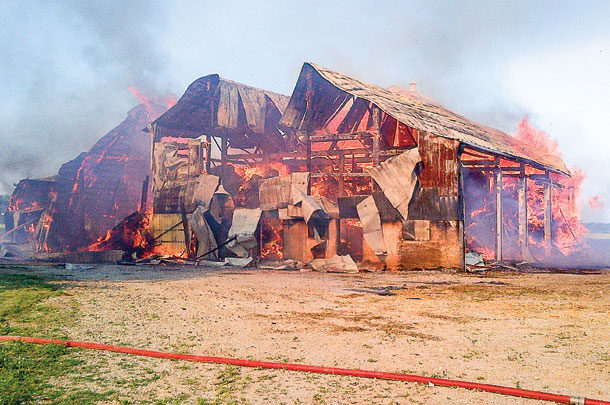Whether it’s a fully engulfed barn, a silo that ends up a towering inferno or a combine that got way too hot and decided to take the drive shed with it, a fire is usually considered the worst possible thing that can happen. Ask any farm owner that has had a fire, and they’ll tell you that there is a lot more at stake than the barn.
How (or why) it all started
When discussing any sort of fire, the first question asked is: “How did it start?” Some may consider this to be semantics, but the “how” is always the same: There was an unfortunate combination of oxygen, heat and fuel. So really, that question is not exactly helpful, but its answer is important.
The question that really needs to be asked is: “Why did the fire start?” This question takes us back to the first answer – meaning, which of the three elements should have been prevented?
Let’s look at some of the most common ways those elements come into play.
-
Fuel – Something has to ignite and feed a fire. Barns are perfect habitats as hay, straw, dust and cobwebs make prime fuel candidates. Oily rags, crops, grass and wood are also common elements that can be ignited and continue to feed a fire.
-
Heat – Common heat sources for farm-related fires are hay/straw (spontaneous combustion), heating systems (everything from heat lamps to radiant tube heaters), hot equipment (vehicles, large equipment and welding tools) and electrical components such as wiring and fuse panels. Exposure to lightning, cigarettes and outdoor fires easily increase the risk of a structure fire.
- Oxygen – The nature of farm buildings is that they were designed, for the most part, to allow ventilation and air circulation. While that is great for farming, it certainly doesn’t help when it comes to preventing or extinguishing a fire. Often, installed fire separation walls are compromised with the installation of wiring, plumbing and other utility systems.
How to stop it before it starts
Every farm operation has a different financial position. We’ve broken down the fire prevention tips in Table 1 into three categories based on their cost: high, medium and low.

Fire safety for everyone
Regardless of financial position, there are a number of things you can do to ensure you have a more fire-safe farm:
1. Do not allow smoking in or around barns or near any flammable farm materials.
2. Situate manure piles at least 10 meters away from barns to reduce the chance of combustion.
3. Ensure hay and straw are properly dried before storing it in the barn and monitor its temperature.
4. Keep dust and cobwebs to a minimum.
5. For horse barns, leave horses haltered or hang halters and leads on stall doors, should evacuation be required.
6. Question and remove unknown, unlicensed and unauthorized persons from the premises.
7. Regularly check all appliances, wiring, electrical equipment and heat-producing materials and equipment to ensure everything is in safe, working order.
8. Repair or replace any frayed or damaged wiring as soon as it is identified.
9. Never refuel engines inside a building or while the engine is running or hot.
10. Extension cords should only be used temporarily and should be removed after use.
11. Park equipment and vehicles indoors only after they have cooled down.
12. Ensure all buildings and vehicles have fire extinguishers, and that everyone who frequents your property knows how to use them.
Help is available
Does your farm have a fire safety plan? Do buildings containing animals have an evacuation plan? Are you, your family members, employees or frequent visitors trained in fire safety?
Do they know what to look for when touring the barn or operating equipment and vehicles? If a fire started, would everyone know what to do?
Your local fire department can help you answer those questions with a “yes.” Most fire departments will have fire prevention and public education personnel that can work with you to address those questions. Many will do so for a reasonable fee or at no charge at all.
If your local fire department doesn’t have a farm fire safety program, they can adopt one easily. For farm fire safety information or for information on fire department program resources, visit www.pertheast.ca/ffsc
Let’s all help in building a farm fire-safe community; remember, there’s more at stake than the barn. PD
Tanya Bettridge is with the Perth East Fire Department, which is made up of a roster of 68 firefighters between three stations located in Milverton, Sebringville and Shakespeare, Ontario.
PHOTO: Photo provided by Perth East Fire Department.








